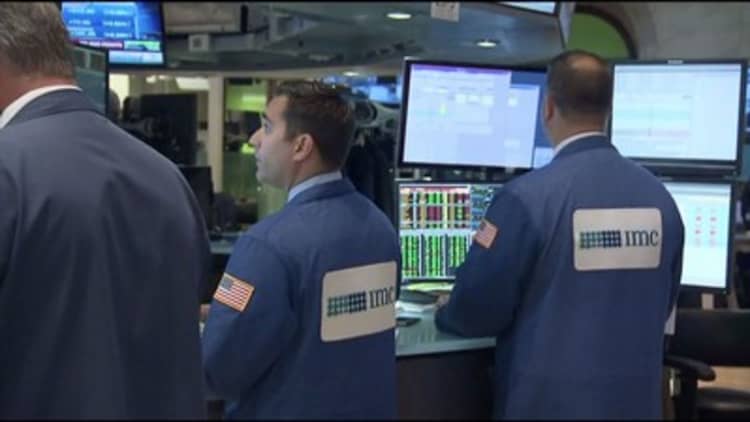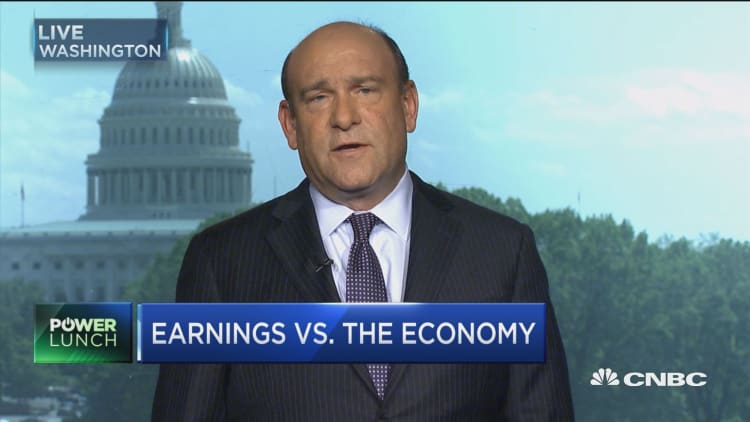
So far this earnings season, the less a U.S. company is exposed to America, the better its results.
S&P 500 companies that generate more than half their revenue overseas are posting first-quarter earnings growth of 19.9 percent on average, double that of companies that conduct most of their business domestically, according to FactSet. About 60 percent of the S&P 500 has reported results.
That helps explain the gap between the strong quarterly results and sluggish economic data like Friday's report showing U.S. GDP increased at just 0.7 percent in the first quarter, its slowest pace in three years. In fact, a CNBC analysis found that the difference between earnings per share growth and gross domestic product expansion in the first quarter is the widest since the third quarter of 2011.
"We're seeing some pickup in growth that's outside the U.S. that's being reflected in these earnings numbers," said Nick Raich, CEO of The Earnings Scout, pointing out that "the U.S. data is domestic focused."
About 46 percent of S&P 500 sales overall come from foreign markets.
The U.S. is still the world's largest economy, but its growth has stagnated while that of the rest of the world has been picking up.
The International Monetary Fund last month raised its annual growth forecasts for China and the euro area by 0.1 percent from its report in January. The estimate for the U.S. economy was unchanged.
The IMF raised estimates for Japan and the U.K. by 0.4 percent and 0.5 percent, respectively, for an estimated overall 0.1 percent uptick in global growth this year. This time last year, the IMF had cut its global growth outlook by 0.2 percent.

Key reasons for last year's sluggishness was a plunge in oil prices and other commodities prices, that added to the struggles of China as it attempts to transition its economy away from manufacturing exports to developing its services industry.
As a result, major U.S. firms dependent on China and commodities markets have surprised in the first quarter of this year.
For example, Caterpillar crushed earnings estimates and posted its first year-over-year sales increase in more than two years. The Dow component said its Asia Pacific sales rose 12 percent "primarily due to an increase in construction equipment sales in China resulting from increased infrastructure and residential investment."
In the first quarter of last year, Caterpillar's Asia Pacific sales dropped 23 percent.
U.S. banks have also posted strong first-quarter earnings, helped by rising interest rates, improving global growth and increased trading revenues. Bank of America, JPMorgan Chase and Morgan Stanley reported large earnings beats that contributed substantially to the S&P 500's earnings growth in the first quarter, according to FactSet.
Overall S&P 500 earnings per share growth is on track for an increase of more than 12 percent for the first quarter, the greatest since the third quarter of 2011.
Other factors helping earnings and overseas economic growth are softness in the U.S. dollar and stabilizing oil prices.
The greenback has traded mostly lower this year after sharp gains in 2014 and 2015 that cut into overseas profits.
Meanwhile, oil recovered from a sub-$30 a barrel low last February to trade in a range near $50 a barrel. U.S. crude is up about 7 percent over the last 12 months.
To be sure, there's another reason why earnings look so good: A year ago, they were pretty bad.
Last year's poor results for S&P 500 companies overall, including four straight quarters of earnings decline, set a low bar for companies to overcome. Matching improved growth in coming months may be more difficult.
But they continue to grow at a healthy pace with help from the globe.
"We have been more focused on improving global growth than on the 'Trump trade,'" hedge fund manager Dan Loeb told clients in a Thursday letter obtained by CNBC.
"Although S&P earnings were flat over the past three years," Loeb said, "we are expecting earnings growth to drive gains and cyclical names to get a tailwind from U.S. policy shifts this year."
Third Point has doubled the market's return over the last two decades.
— CNBC's Scott Wapner and John Melloy contributed to this report.


